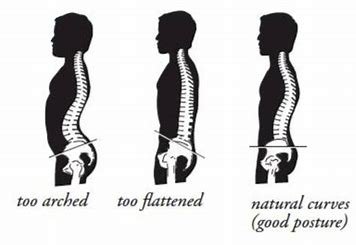
🌟 What is Neutral Spine Alignment?
Neutral spine alignment refers to the natural curve of your spine when it’s in a position where the head, shoulders, and hips are properly aligned. This position:
- Keeps the natural curve of the cervical (neck), thoracic (mid-back), and lumbar (lower back) regions intact.
- Reduces unnecessary strain on the spine, muscles, and connective tissues.
- Supports efficient movement and balance.
In a neutral spine:
- The lower back (lumbar spine) has a slight curve (lordosis).
- The upper back (thoracic spine) has a slight curve outward (kyphosis).
- The neck (cervical spine) has a curve inward (lordosis).
🏋️♂️ Why Neutral Spine is Important During Exercise
- Prevents Injury:
- Excessive arching or rounding of the spine (often referred to as hyperextension or flexion) can put undue pressure on the vertebrae, discs, and surrounding muscles.
- A neutral spine ensures proper load distribution and reduces the risk of injury, especially in high-impact or weight-bearing exercises like squats, deadlifts, and overhead presses.
- Improves Posture:
- When you maintain a neutral spine, you’re training your body to hold itself in proper alignment. Over time, this helps improve your overall posture—both during exercise and in daily activities.
- Enhances Performance:
- A stable core and neutral spine create a solid foundation for movement, helping you generate more power and efficiency during your exercises.
- For example, in movements like squats or deadlifts, keeping the spine neutral allows you to transfer force through your hips and legs more effectively.
- Reduces Muscle Fatigue:
- Maintaining proper alignment helps to engage the right muscles and prevents overuse or strain on others, which can lead to fatigue and muscle imbalances.
💪 How to Maintain Neutral Spine Alignment in Exercises
1. Core Engagement
- Key to neutral spine: The core (abdominals, obliques, lower back muscles) provides support to your spine, ensuring that it stays in the correct position. Engaging your core during exercises helps stabilize the spine and keep it neutral.
How to engage your core:
- Imagine you’re about to get punched in the stomach. Draw your navel toward your spine while keeping your ribcage slightly down.
- You should feel a firming sensation in your midsection, but still be able to breathe.
2. Pelvic Positioning
- Neutral pelvis: Your pelvis should be in a natural, neutral position (not tilted excessively forward or backward).
- Anterior pelvic tilt (arched lower back) occurs when the pelvis tilts forward, creating an exaggerated curve in the lower back.
- Posterior pelvic tilt (flattened lower back) happens when the pelvis tilts backward, causing the spine to round.
How to maintain a neutral pelvis:
- Standing: Imagine gently tucking your pelvis under while keeping your chest up, maintaining the natural curve of your lower back.
- During exercises like squats or deadlifts: Avoid letting your lower back arch excessively by focusing on keeping your pelvis stable.
🏋️♂️ Exercises to Focus on Neutral Spine Alignment
Here are some exercises where maintaining a neutral spine is particularly important:
1. Squats
- How to do it: Keep your spine neutral by engaging your core and maintaining a slight natural curve in your lower back. Don’t round or excessively arch your back during the squat.
- Tip: Imagine sitting back into a chair, keeping your chest lifted and your back straight as you squat down.
2. Deadlifts
- How to do it: Start with your feet hip-width apart, barbell close to your shins, and your spine in a neutral position. Engage your core and keep the barbell close to your body as you hinge at your hips, maintaining a flat back.
- Tip: Avoid rounding your back at any point during the lift. Push your hips back as you lower the weight, and squeeze your glutes at the top.
3. Planks
- How to do it: Keep your body in a straight line from your head to your heels, engaging your core and glutes. Avoid letting your lower back dip or your upper back arch.
- Tip: Focus on keeping your hips level with the rest of your body to avoid excessive arching in the lower back.
4. Overhead Press
- How to do it: When pressing a weight overhead, maintain a neutral spine by engaging your core and keeping your ribs from flaring out. Avoid arching your lower back excessively when the barbell is overhead.
- Tip: Keep your glutes tight and your ribs pulled down as you press the weight, ensuring a stable base.
🧘♀️ Tips to Correct and Improve Your Neutral Spine During Exercise:
- Check your alignment regularly: During exercises, take periodic mental checks to ensure your spine stays neutral. If needed, pause and reset.
- Use a mirror or video: Watching yourself in a mirror (or recording your movements) can help you spot when you’re deviating from neutral spine alignment.
- Practice core exercises: Exercises like planks, bird-dogs, and dead bugs specifically target core stability, making it easier to engage your core during other movements.
- Incorporate mobility work: Tight hip flexors, hamstrings, or back muscles can affect your spinal alignment. Incorporating mobility exercises for these areas can help improve your neutral spine position.
🧠 Key Takeaways:
- Engage your core: Core stability is the key to keeping your spine neutral.
- Avoid excessive arching or rounding: Both of these can strain your spine and lead to injury.
- Focus on posture throughout the movement: Keep your body aligned, and the natural curves of your spine intact.
- Stay mindful of pelvic position: A neutral pelvis helps maintain spinal alignment.
